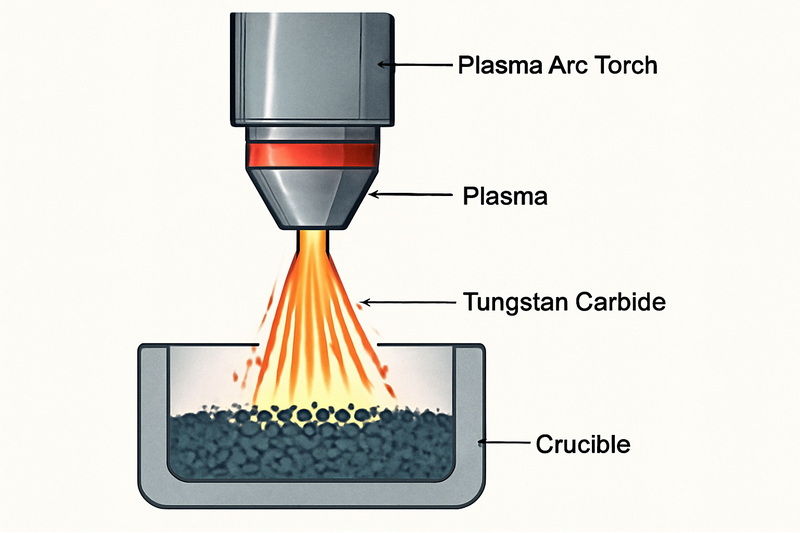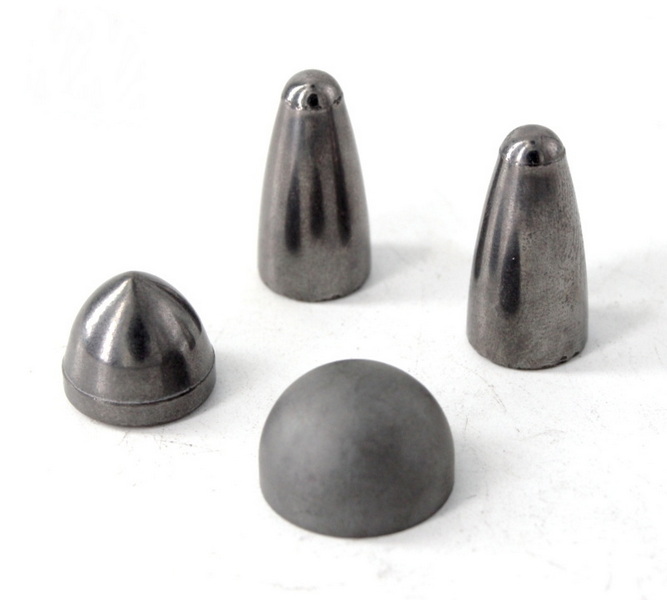Content Menu
● Introduction to Tungsten Carbide
● The Science of Melting Tungsten Carbide
● Challenges in Melting Tungsten Carbide
● Types of Machines That Can Melt Tungsten Carbide
>> Induction Furnaces
>> Plasma Arc Melting Furnaces
>> Vacuum Sintering Furnaces
>> Electron Beam Melting Machines
>> Carburizing Furnaces
>> Laser Melting Systems
● Key Considerations When Choosing a Melting Machine
● The Melting Process: Step-by-Step
>> 1. Preparation of Material
>> 2. Loading into the Furnace
>> 3. Atmosphere Control
>> 4. Heating
>> 5. Melting
>> 6. Casting or Forming
>> 7. Cooling and Solidification
>> 8. Post-Processing
● Industrial Applications of Melted Tungsten Carbide
● Innovations and Future Trends
● Safety and Environmental Concerns
● Conclusion
● FAQ
>> 1. What is the highest temperature required to melt tungsten carbide?
>> 2. Why is an inert or vacuum atmosphere necessary when melting tungsten carbide?
>> 3. Can tungsten carbide be melted using a standard metal furnace?
>> 4. What safety precautions are essential when operating a tungsten carbide melting machine?
>> 5. How is melted tungsten carbide typically used in industry?
Tungsten carbide is a material synonymous with extreme hardness, durability, and resistance to wear. Its unique properties make it invaluable in industries ranging from mining and machining to aerospace and defense. However, these very properties also make tungsten carbide notoriously difficult to melt, process, and recycle. The question, “What machine can melt tungsten carbide?” is both highly technical and critically important for modern manufacturing. This comprehensive article explores the science behind melting tungsten carbide, the advanced machines capable of the task, the industrial applications, and the future of this remarkable material.

Introduction to Tungsten Carbide
Tungsten carbide is a composite material formed by combining tungsten and carbon atoms, usually with a metallic binder such as cobalt. The resulting compound is exceptionally hard—nearly as hard as diamond—and has a melting point above 2,870°C (5,198°F). Its resistance to abrasion, corrosion, and high temperatures makes it the material of choice for cutting tools, mining equipment, armor-piercing ammunition, and wear-resistant components.
The Science of Melting Tungsten Carbide
Melting tungsten carbide is a complex process that involves overcoming the strong chemical bonds between tungsten and carbon. Unlike pure metals, which have relatively straightforward melting points, tungsten carbide's composite nature means that melting it can lead to decomposition or changes in composition if not carefully controlled.
When heated above its melting point, tungsten carbide can break down into tungsten and carbon, especially in the presence of oxygen or other reactive gases. Therefore, the melting process must be conducted in a controlled atmosphere—typically a vacuum or inert gas environment—to maintain the integrity of the material.
Challenges in Melting Tungsten Carbide
Melting tungsten carbide presents several unique challenges:
- Extremely High Melting Point: Most conventional furnaces cannot achieve the necessary temperatures.
- Chemical Stability: At high temperatures, tungsten carbide can react with oxygen, nitrogen, or even the crucible material, leading to contamination or loss of material.
- Decomposition Risk: Improper temperature control can cause tungsten carbide to decompose rather than melt.
- Uniform Heating: Ensuring uniform heat distribution is critical to avoid hot spots, which can lead to uneven melting or structural defects.
- Energy Consumption: High-temperature processes consume significant amounts of energy, making efficiency a key concern.
Types of Machines That Can Melt Tungsten Carbide
Induction Furnaces
Induction furnaces are a mainstay in the melting of refractory metals and alloys. They use electromagnetic induction to heat the material directly, allowing for rapid and uniform temperature increases. The furnace consists of a coil through which alternating current passes, generating a magnetic field that induces eddy currents in the tungsten carbide charge, heating it efficiently.
Key Features:
- Achieves temperatures up to and beyond 2,700°C.
- Allows for precise temperature control and rapid heating.
- Often equipped with vacuum or inert gas chambers to prevent oxidation.
- Suitable for both batch and continuous melting processes.
Plasma Arc Melting Furnaces
Plasma arc melting furnaces utilize a high-energy plasma torch to generate temperatures far exceeding those achievable by conventional means. The plasma, an ionized gas, can reach temperatures of over 15,000°C, easily melting tungsten carbide and other ultra-high temperature materials.
Key Features:
- Extremely high temperature capability.
- Can process large batches or continuous streams of material.
- Operates in controlled atmospheres to prevent contamination.
- Suitable for recycling and refining tungsten carbide scrap.
Vacuum Sintering Furnaces
Vacuum sintering furnaces are primarily used for the production of tungsten carbide parts rather than full melting. In these furnaces, tungsten carbide powder is compacted into a desired shape and heated until the binder (typically cobalt) melts, causing the particles to bond without fully liquefying the tungsten carbide.
Key Features:
- Operates at temperatures up to 1,700°C or higher.
- Utilizes vacuum or inert gas to prevent oxidation.
- Produces dense, high-strength tungsten carbide components.
- Essential for manufacturing cutting tools and wear parts.
Electron Beam Melting Machines
Electron beam melting (EBM) machines employ a focused beam of high-energy electrons to selectively melt tungsten carbide. The process occurs in a high vacuum, which prevents contamination and allows for precise control over the melting zone.
Key Features:
- Highly localized heating for precision melting.
- Used in additive manufacturing and specialized casting.
- Operates under high vacuum to maintain material purity.
- Suitable for both powders and solid forms.
Carburizing Furnaces
Carburizing furnaces are used to produce tungsten carbide from tungsten powder and carbon, but they can also be adapted for melting or sintering. These furnaces operate at high temperatures and use controlled atmospheres to prevent unwanted reactions.
Key Features:
- Temperatures up to 2,300°C.
- Controlled gas atmospheres (hydrogen, nitrogen, argon).
- Used for both initial synthesis and processing of tungsten carbide.
- Automated loading and unloading for industrial-scale production.
Laser Melting Systems
Laser melting systems are at the forefront of modern materials processing. They use high-powered lasers to selectively melt tungsten carbide, often layer by layer, enabling the creation of complex geometries through additive manufacturing.
Key Features:
- Extremely precise, with localized heating.
- Enables 3D printing of tungsten carbide parts.
- Operates in inert or vacuum environments.
- Ideal for rapid prototyping and custom components.

Key Considerations When Choosing a Melting Machine
Selecting the right melting machine for tungsten carbide involves a careful evaluation of several factors:
- Temperature Capability: The machine must reliably reach and sustain temperatures above 2,700°C.
- Atmosphere Control: Preventing oxidation and contamination is essential; machines should offer vacuum or inert gas options.
- Batch Size and Throughput: Industrial operations may require large-scale continuous furnaces, while research labs might use smaller, more precise equipment.
- Material Compatibility: The crucible and furnace materials must withstand high temperatures and avoid reacting with tungsten carbide.
- Energy Efficiency: High-temperature processes are energy-intensive; efficient designs reduce operational costs.
- Automation and Monitoring: Modern machines feature automated controls, real-time monitoring, and safety interlocks for improved productivity and safety.
The Melting Process: Step-by-Step
Understanding the step-by-step process of melting tungsten carbide helps clarify why specialized machines are necessary.
1. Preparation of Material
Tungsten carbide is typically supplied as powder, scrap, or pre-formed components. The material must be clean and free of contaminants to ensure high-quality melting.
2. Loading into the Furnace
The material is loaded into a crucible made from a refractory material such as graphite or alumina, which can withstand the extreme temperatures involved.
3. Atmosphere Control
The furnace chamber is evacuated to create a vacuum or filled with an inert gas such as argon to prevent oxidation and contamination.
4. Heating
The chosen heating method—induction, plasma arc, electron beam, or laser—is applied. The temperature is gradually increased to avoid thermal shock and ensure uniform heating.
5. Melting
Once the target temperature is reached, tungsten carbide begins to melt. Precise temperature control is maintained to prevent decomposition or unwanted reactions.
6. Casting or Forming
The molten tungsten carbide can be cast into molds, atomized into powder, or processed into desired shapes using various techniques.
7. Cooling and Solidification
The material is carefully cooled, often under controlled conditions, to achieve the desired microstructure and properties.
8. Post-Processing
Final steps may include machining, grinding, or surface treatments to achieve the required specifications.
Industrial Applications of Melted Tungsten Carbide
Melted and processed tungsten carbide finds use in a wide range of industries:
- Cutting Tools: Drill bits, end mills, saw blades, and inserts for machining metals, stone, and composites.
- Mining and Drilling: Wear-resistant components for rock drilling, excavation, and mineral processing.
- Aerospace: High-performance nozzles, bearings, and structural components exposed to extreme conditions.
- Automotive: Valve seats, fuel injector parts, and wear-resistant coatings for engine components.
- Defense: Armor-piercing projectiles and protective armor for vehicles and personnel.
- Additive Manufacturing: Custom parts and prototypes with complex geometries.
Innovations and Future Trends
The field of tungsten carbide processing is rapidly evolving, with several key trends shaping the future:
- Additive Manufacturing: Advances in laser and electron beam melting are enabling the 3D printing of tungsten carbide parts with unprecedented complexity and performance.
- Recycling Technologies: New plasma and induction melting techniques are making it possible to recycle tungsten carbide scrap efficiently, reducing waste and resource consumption.
- Hybrid Furnaces: Combining multiple heating methods (e.g., induction and plasma) offers improved control and energy efficiency.
- Smart Furnaces: Integration of sensors, AI-driven controls, and real-time monitoring is enhancing process reliability and product quality.
- Green Processing: Efforts to reduce energy consumption and minimize environmental impact are driving the development of more sustainable melting technologies.
Safety and Environmental Concerns
The extreme conditions required to melt tungsten carbide necessitate rigorous safety protocols and environmental safeguards:
- Operator Safety: Personnel must wear heat-resistant protective gear, including gloves, face shields, and insulated suits.
- Gas Handling: Proper ventilation and gas extraction systems are essential to manage the release of potentially hazardous gases.
- Material Handling: Automated loading and unloading systems reduce the risk of burns and exposure to toxic substances.
- Waste Management: Recycling and responsible disposal of byproducts and used crucibles minimize environmental impact.
- Regulatory Compliance: Facilities must adhere to strict regulations governing high-temperature operations and hazardous materials.
Conclusion
Melting tungsten carbide is a highly specialized process that demands advanced technology, precise control, and a deep understanding of materials science. From induction and plasma arc furnaces to cutting-edge laser and electron beam systems, a range of machines are available to meet the unique challenges posed by this remarkable material. As industries continue to push the boundaries of performance and sustainability, innovations in tungsten carbide melting technology will play a pivotal role in shaping the future of manufacturing.

FAQ
1. What is the highest temperature required to melt tungsten carbide?
The melting point of tungsten carbide is above 2,700°C, and specialized furnaces must reach or exceed this temperature for effective melting.
2. Why is an inert or vacuum atmosphere necessary when melting tungsten carbide?
An inert or vacuum atmosphere prevents oxidation and contamination of tungsten carbide at high temperatures, ensuring the purity and quality of the melted material.
3. Can tungsten carbide be melted using a standard metal furnace?
No, standard metal furnaces do not reach the high temperatures required for melting tungsten carbide. Specialized equipment such as induction or plasma arc furnaces is necessary.
4. What safety precautions are essential when operating a tungsten carbide melting machine?
Operators must use heat-resistant protective gear, maintain proper ventilation, and follow strict safety protocols to manage the extreme heat and potential release of hazardous gases.
5. How is melted tungsten carbide typically used in industry?
Melted tungsten carbide is cast or formed into cutting tools, wear-resistant components, nozzles, and parts for industries such as mining, machining, aerospace, and automotive.
















